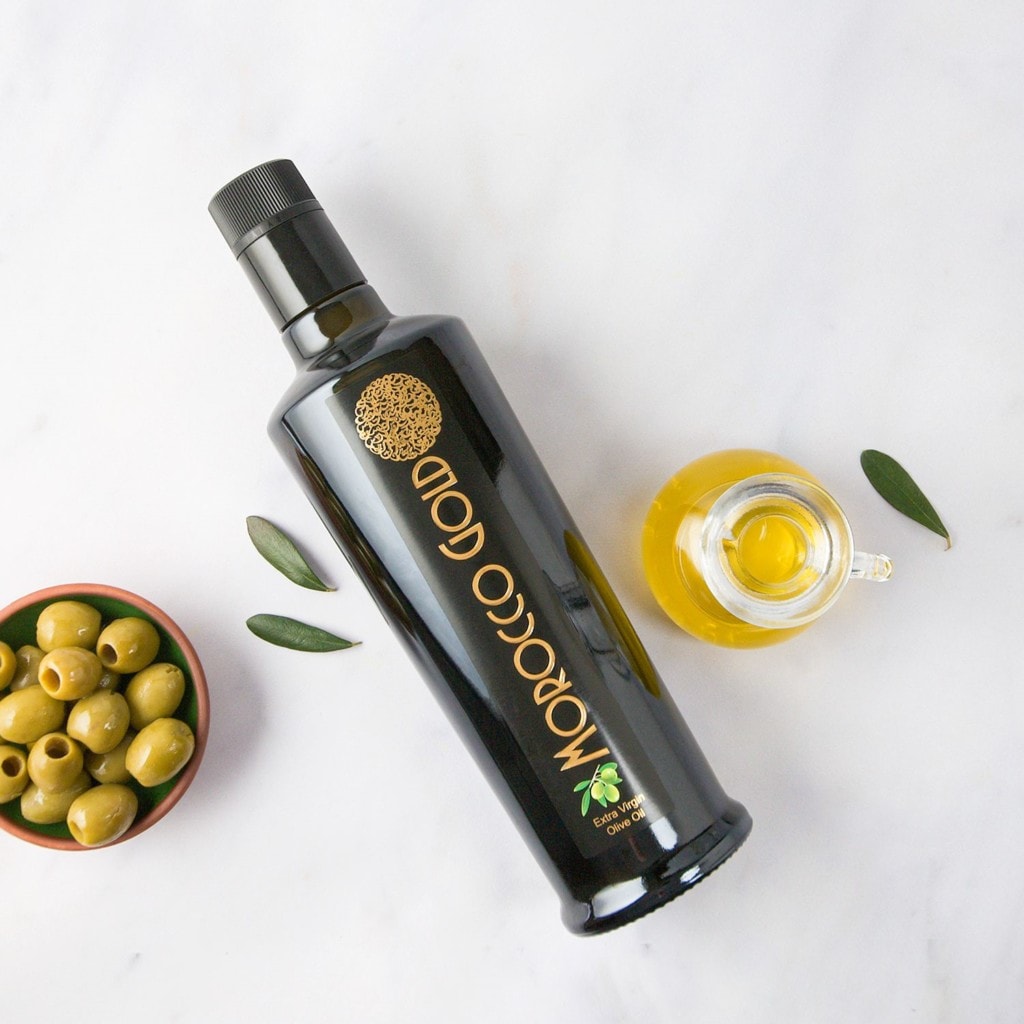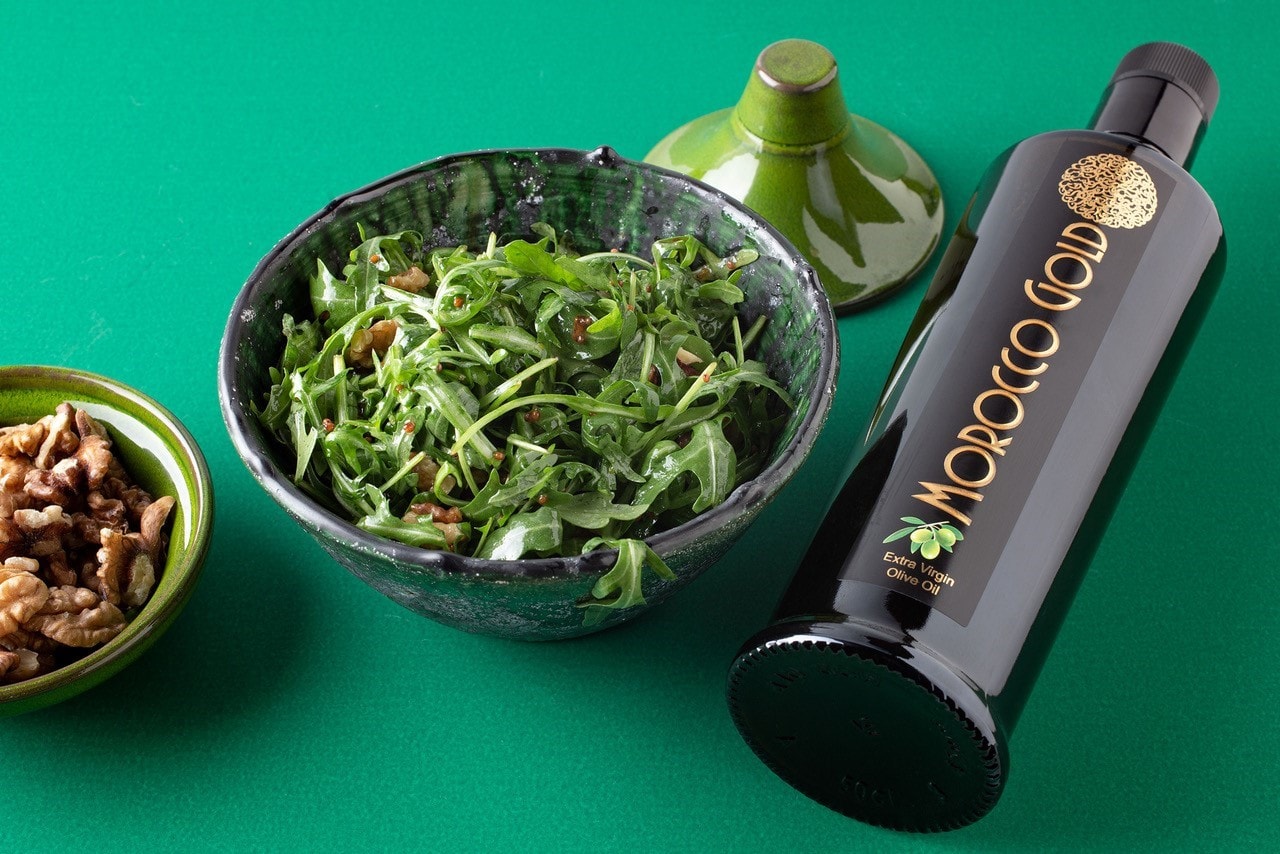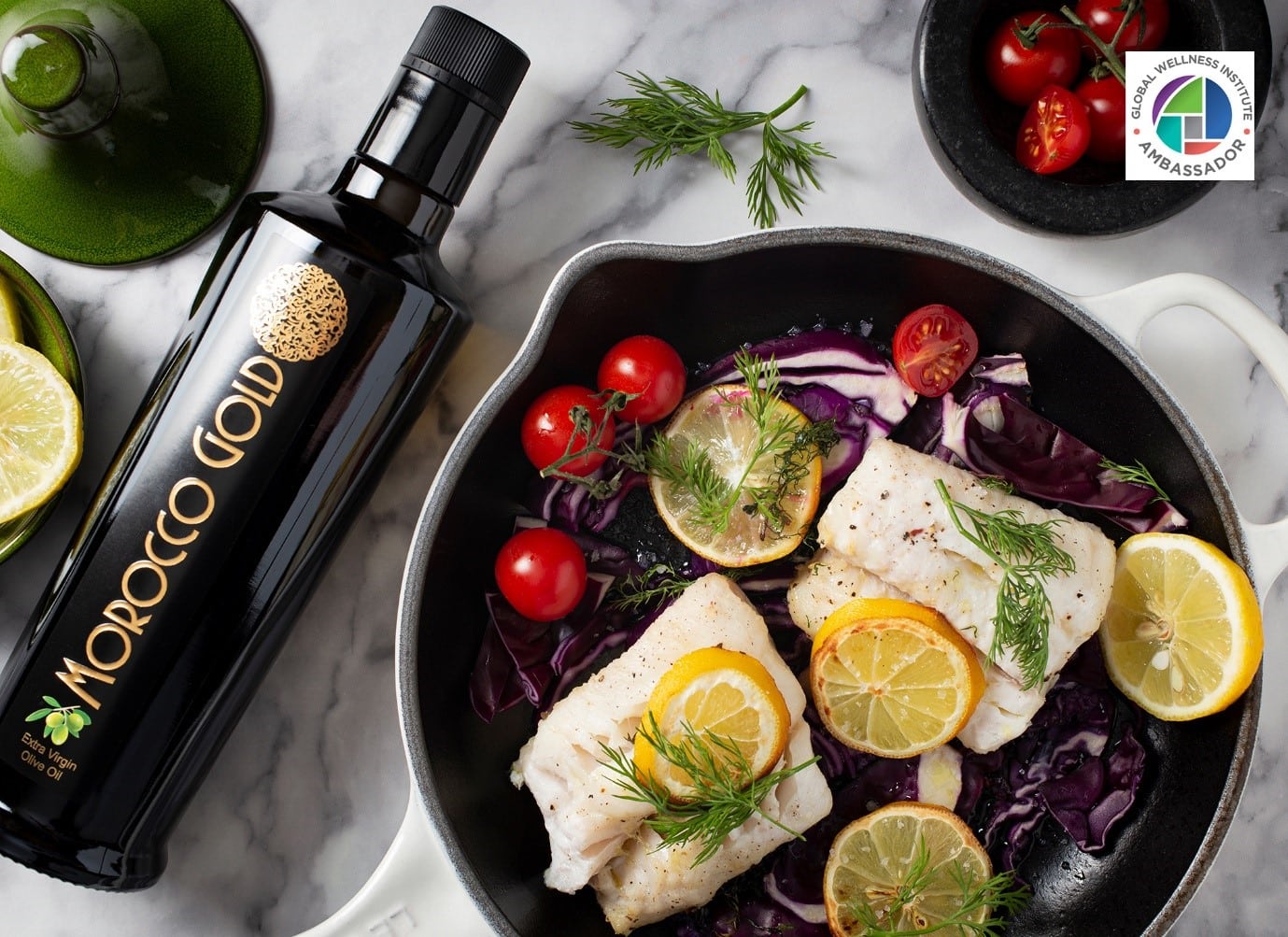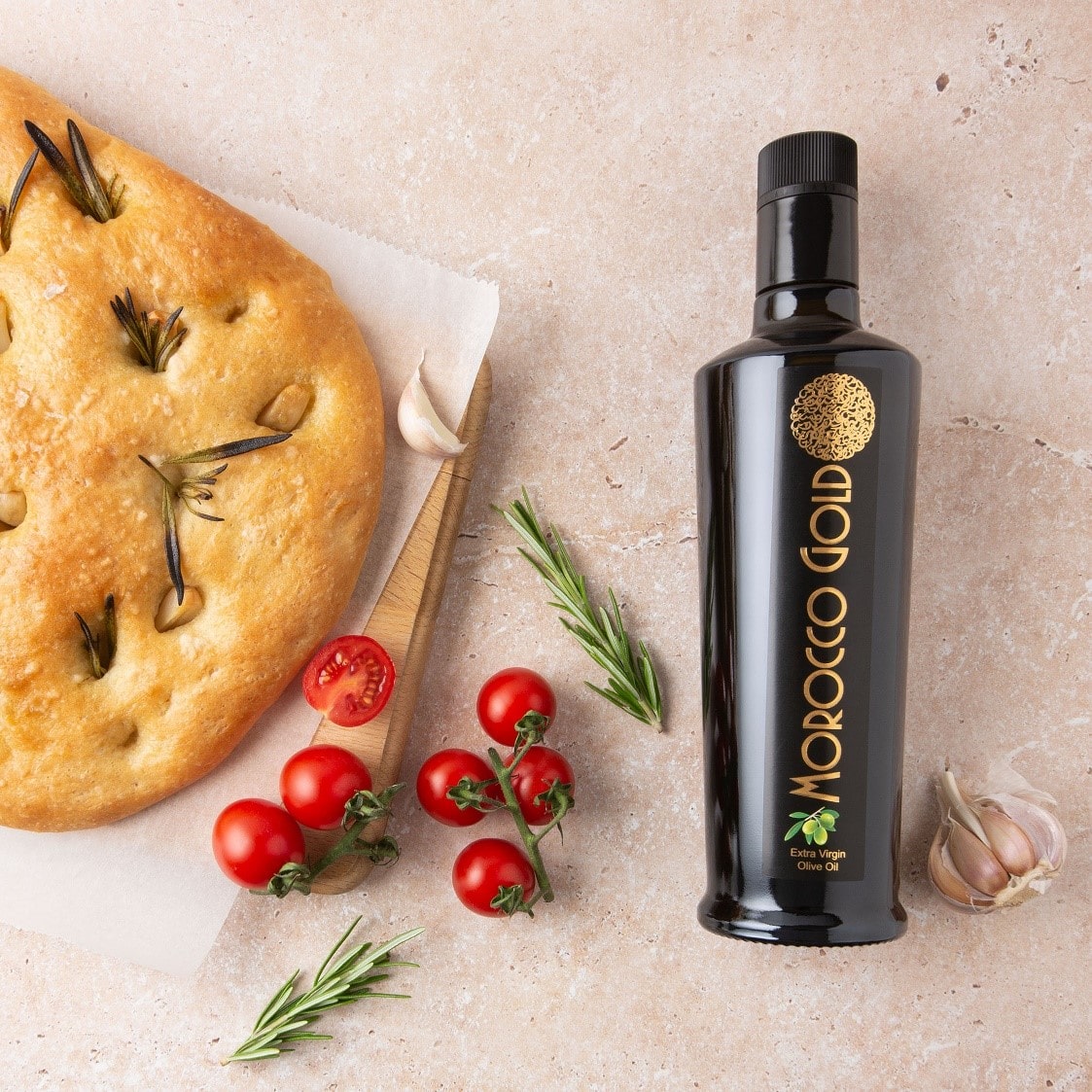
Summary
- Understanding how EVOO can elevate certain dishes and how best to use it
- How to use different grades of olive oil for different purposes
- Choosing the right oil for you
- Considering the source, price and value
Contents
- What is Extra Virgin Olive Oil?
- How is it superior to the staple olive oil?
- What are their different uses in cooking?
- How to choose the best EVOO
- Why Choose Morocco Gold Extra Virgin Olive Oil
What is Extra Virgin Olive Oil?
Extra-virgin olive oil is the unrefined highest-quality olive oil, made by cold-pressing whole olives without any additional heat or chemicals.
Certifying olive oil as extra virgin olive oil (EVOO) involves a combination of chemical testing and sensory evaluation. Various organisations set the standards for EVOO, with the International Olive Council (IOC) being the most recognised. Here are the steps and criteria involved in certifying olive oil as EVOO:
1. Harvesting and Processing
- Olives are harvested at the right stage of ripeness.
- They are processed soon after harvesting to avoid fermentation and degradation. The oil is extracted using mechanical methods (cold pressing), without the use of heat or chemicals.
2. Chemical Testing
Olive oil must meet specific chemical parameters to be classified as EVOO. These tests include:
- Free Acidity: Measures the amount of free fatty acids. EVOO must have a free acidity of no more than 0.8 grams per 100 grams (0.8%).
- Peroxide Value: Indicates the level of oxidation. EVOO should have a peroxide value of less than 20 milliequivalents of active oxygen per kilogram of oil.
- UV Absorption: Measures the absorbance of ultraviolet light at specific wavelengths (K232, K270, and ΔK). These values indicate the presence of oxidation compounds.
- Fatty Acid Composition: Analyses the types and proportions of fatty acids. EVOO must have a specific profile, with a high percentage of monounsaturated fats (especially oleic acid).
- Other Chemical Tests: May include tests for wax content, sterol composition, and the presence of specific volatile compounds.
3. Sensory Evaluation (Organoleptic Assessment)
Qualified tasters conduct a sensory evaluation to assess the taste, smell, and overall quality of the olive oil. This evaluation involves:
- The oil must exhibit positive attributes such as fruitiness, bitterness, and pungency.
- The oil must be free from defects such as rancidity, mustiness, fustiness, and other flavour defects.
A panel of trained tasters evaluates the oil using a standardised method and scoring system. To be classified as EVOO, the oil must score well in terms of positive attributes and show no sensory defects.
4. Certification and Labelling
Once the olive oil passes both chemical and sensory tests, it can be certified as extra virgin olive oil. The certification process typically involves:
- Producers providing documentation of the production process, including harvesting, milling, and storage.
- The oil complying with the standards set by the relevant certifying body, such as the IOC, European Union (EU), or other national organisations.
- Certifying EVOO by labelling accordingly, indicating its quality and compliance with required standards.
- Periodic Testing and Monitoring
To ensure ongoing compliance, producers and certifying bodies may conduct periodic testing and monitoring of the oil. This helps maintain quality and integrity in the market.
Overall, the certification of olive oil as extra virgin involves stringent testing and evaluation to ensure the highest quality, purity, and authenticity. The taste of extra virgin olive oil will depend on the type of olive, ranging from buttery and herbal to peppery and bitter.
How is it different from the staple Olive Oil?
The primary differences between olive oil and extra virgin olive oil lie in their production methods, quality, flavour, nutritional content, and intended uses. Here is a detailed comparison:
Production Method:
Extra Virgin Olive Oil: Extracted from olives solely through mechanical means (cold pressing) without the use of heat or chemicals. This method preserves the oil’s natural properties.
Olive Oil: Often a blend of refined olive oil and a small amount of virgin olive oil. The refined oil is produced using heat and/or chemical processes to remove impurities and neutralise the oil, which results in a loss of flavour and some nutritional value.
Quality and Purity:
Extra Virgin Olive Oil: Considered the highest quality olive oil, it must meet stringent standards regarding taste, smell, and chemical composition (e.g., low acidity, typically less than 0.8%).
Olive Oil: Generally, of lower quality compared to EVOO. The refining process removes many of the natural flavours and beneficial compounds. It usually has higher acidity levels, up to 2%.
Flavour and Aroma:
Extra Virgin Olive Oil: Has a rich, robust flavour and a fresh, fruity aroma. The taste can vary from mild and buttery to bold and peppery, with a possible slight bitterness or spiciness.
Olive Oil: Milder and more neutral in flavour due to the refining process. It lacks the complexity and intensity of EVOO.
Nutritional Content:
Extra Virgin Olive Oil: Rich in antioxidants, vitamins E and K, and polyphenols, EVOO contains a higher concentration of beneficial compounds due to minimal processing.
Olive Oil: Still contains monounsaturated fats and some vitamins, but the refining process reduces the levels of antioxidants and polyphenols.
Price:
Extra Virgin Olive Oil: Typically, more expensive due to the higher quality and more labour-intensive production process.
Olive Oil: Generally, less expensive as it undergoes refining and is often a blend.
What are their different uses in cooking?
The ideal use for extra virgin olive oil is in cold dishes where it’s beautiful and unique flavour can take centre stage. Of course, plain olive oil can be substituted, but the complex flavour profile of extra virgin olive oil is a standalone culinary experience in itself.
When cooking and frying, it’s best to use regular olive oil as it is high in monounsaturated fats and a healthier alternative to polyunsaturated fats. Whilst you can use extra virgin olive oil for cooking, the heat breaks down the fat molecules, reducing its nutritional benefits and the rich flavour won’t be as apparent and appreciated in a cooked dish.
How to choose the best EVOO
Choosing the best extra virgin olive oil involves considering several factors related to quality, flavour, and authenticity. Here are some tips to help you:
1. Check the Label
Ensure the label clearly states, ‘extra virgin olive oil.’ Other grades like ‘virgin’ or ‘pure’ are of lower quality.
Look for the harvest date rather than just the ‘best by’ date. Fresher oils are generally better, so ideally choose oil that was harvested within the past year.
Check for the country of origin – some high-quality EVOOs come from specific regions known for their olive oil production, such as Italy, Spain, Morocco, Greece, and California.
Look for certifications from reputable organisations, such as the International Olive Council (IOC), the North American Olive Oil Association (NAOOA), or PDO (Protected Designation of Origin) and PGI (Protected Geographical Indication) labels.
2. Examine the Packaging
Choose oils that are stored in dark glass bottles or tins as these containers protect the oil from light, which can degrade its quality.
Ensure the bottle is well-sealed and airtight to prevent oxidation.
3. Consider the Source
Buy from reputable brands or producers known for their high-quality products and purchase from specialty stores or suppliers that focus on high-quality olive oils, rather than generic supermarkets.
4. Read Reviews and Ratings
Look for expert reviews and ratings from trusted sources or olive oil competitions and read consumer reviews to get an idea of the taste and quality from other users’ experiences.
5. Taste and Sensory Qualities
If possible, taste the oil before buying. High-quality EVOO should have a fresh, fruity aroma and a rich, robust flavour with possible hints of bitterness and spiciness. Avoid oils that taste flat, rancid, or musty.
Good EVOO should smell fresh and fruity. If the aroma is off or smells like crayons or putty, it may be past its prime.
6. Price and Value
Higher-quality EVOOs tend to be more expensive due to the meticulous production process and higher standards. Be wary of very cheap options, as they might compromise on quality.
Balance price with value. Sometimes, mid-priced oils offer excellent quality without the premium price tag.
By taking all of this into account, you can select a high-quality extra virgin olive oil that meets your needs and preferences, ensuring a flavourful and healthy addition to your kitchen ingredient staples.
Why Choose Morocco Gold Extra Virgin Olive Oil?
Morocco Gold comes from a single source, from the Beni-Mellal region of Morocco. The olives are harvested by hand, early in the season whilst the fruit is still young and green. The olives are handled with care and attention throughout the harvesting and pressing process to ensure that only the best olives are used for Morocco Gold.
Uniquely, we include the results of our chemical analysis for acidity, peroxide and ultra-violet testing on each and every bottle of Morocco Gold so that our customers can see at a glance the guarantee of extra virgin olive oil quality.
Morocco Gold comes from the Picholine Marrocaine olive, which is characterised by its green, fruity flavour, with hints of almond and herbs, also its high level of polyphenols that give Morocco Gold its health enhancing qualities as well as it’s taste.
It does not have the ‘aggressive’ pungency of some extra virgin olive oils, giving Morocco Gold a well-balanced and satisfying finish. This also makes Morocco Gold highly versatile in how it can be used, either taken directly, dipping with bread, drizzling over salads, sautéing vegetables, the uses are limitless.





